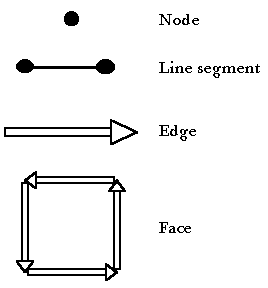
The hierarchy of primitive configurations serving the geometrical structure of objects of different shape and extension in space: in 0D the node, in 1D the line segment or the arc (as intermediary element the edge), in 2D the face. They are built up entirely on each other from down to up. In the database they are intended to ensure optimally without redundance and breaking the geometrical structure of the objects.
The building up of the simple objects is carried out by use of primitives and they can be component of a complex object, too.

Node: Base all objects of the database DAT, lowest level of the geometrical building. Component of the line segments. All the positional information is carried by the node using x, y coordinates and - in many cases optionally - height.
Line - segment: it links two nodes, oriented from the so called initial node toward the so called end node. It is the component of the edge. If two nodes are linked by a curve described by a function, it is about the arc.
Edge: It is an intermediary primitive. It is built up of two or more line-segment of identical orientedness. Part of boundary of a certain face.
Face: Among the primitives contained in this standard it is the most complex. It represents a plane. Its boundary is described by edges of identical orientedness, through which also the face becomes oriented.



 Jump to the Homepage of Department of Cartography and Geoinformatics, Eötvös University, Budapest!
Jump to the Homepage of Department of Cartography and Geoinformatics, Eötvös University, Budapest!